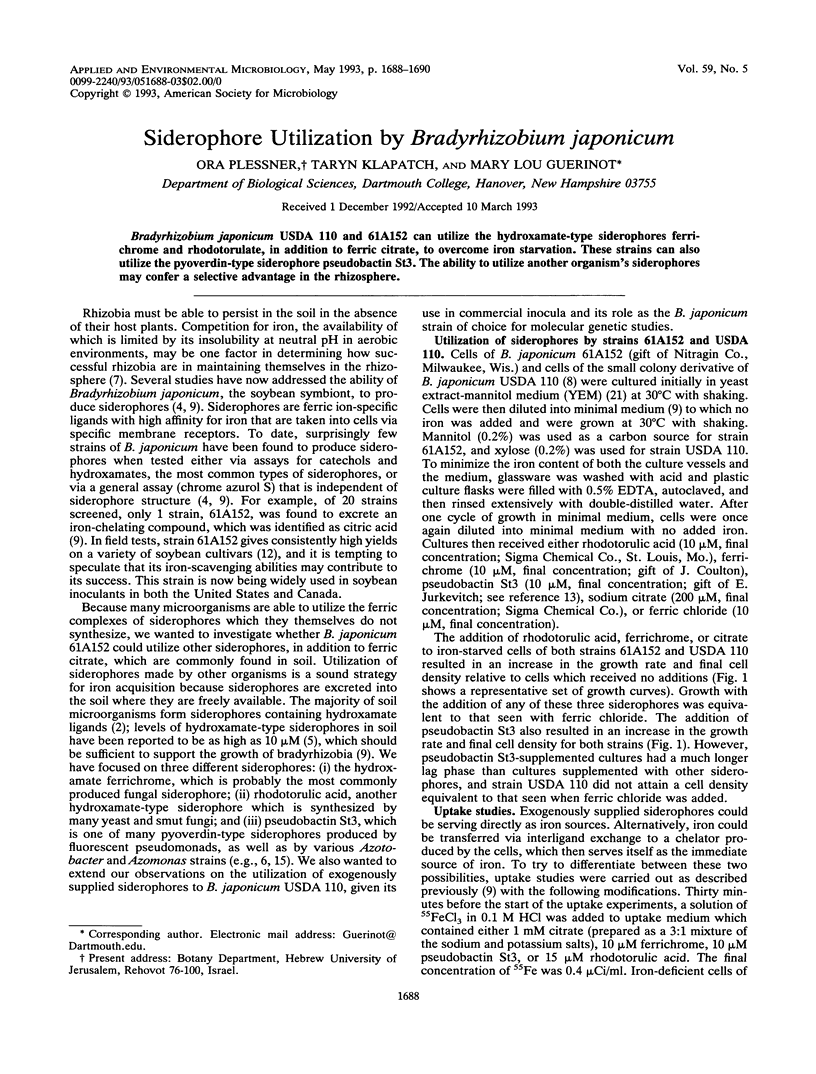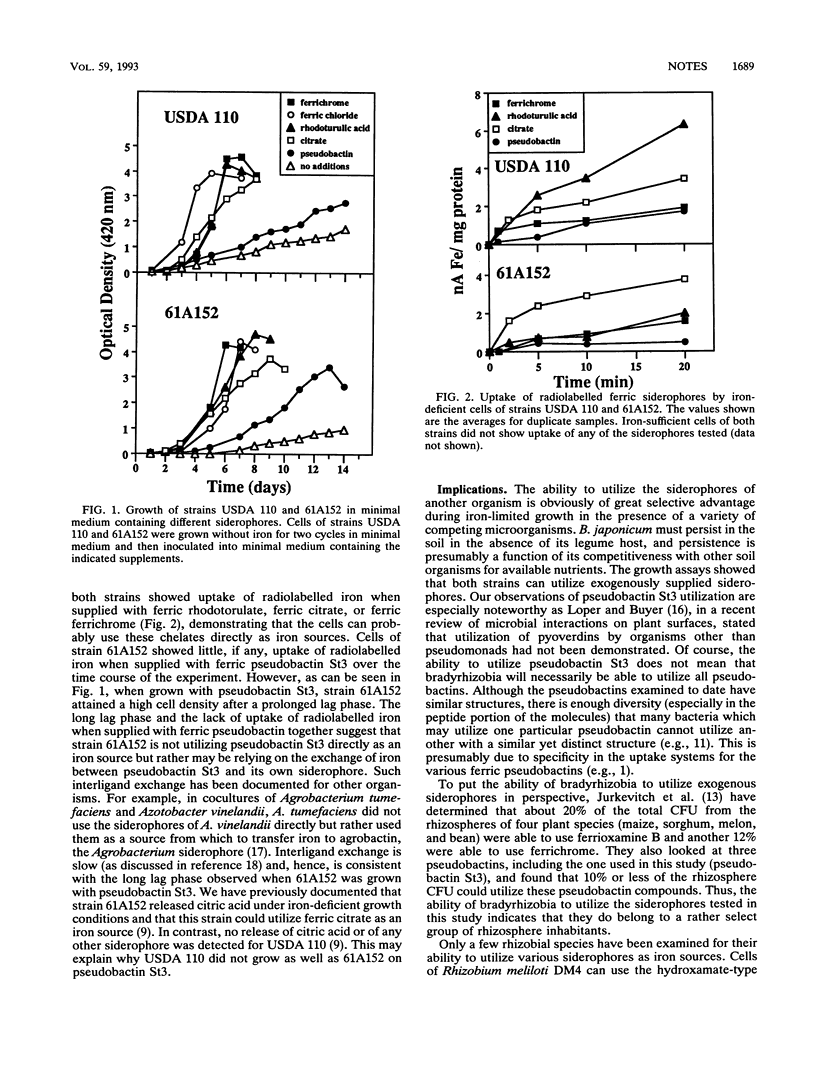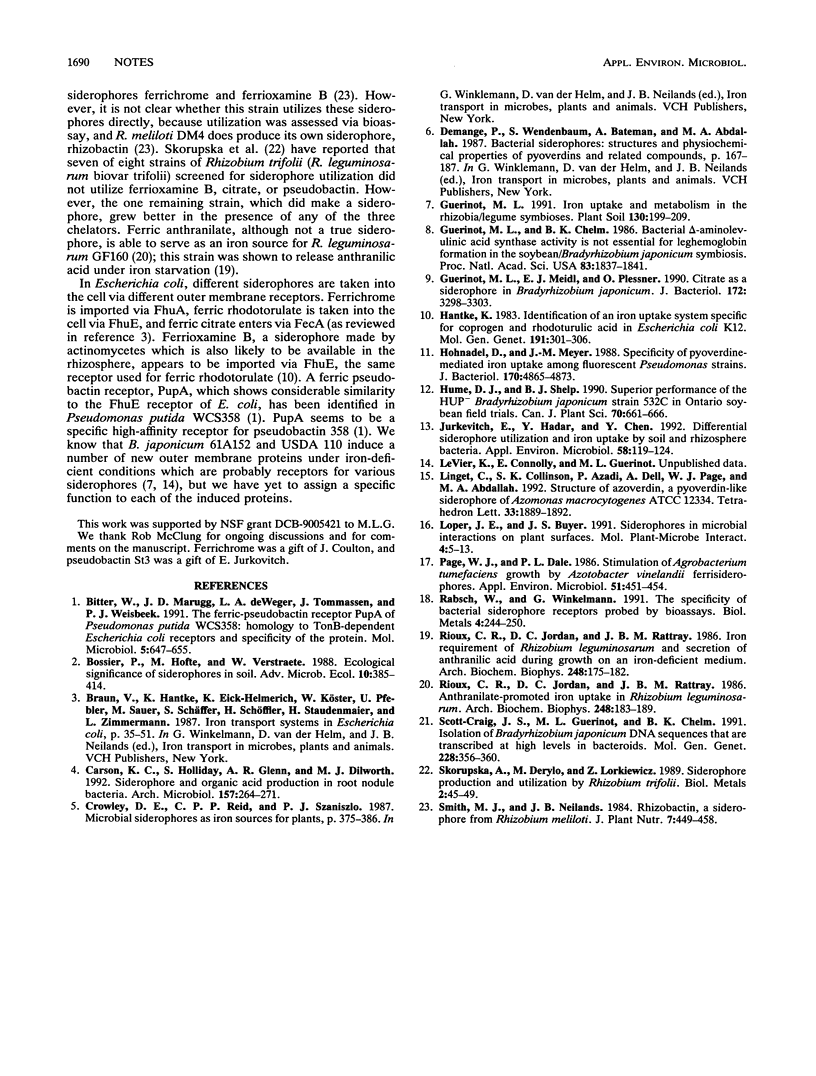Abstract
Bradyrhizobium japonicum USDA 110 and 61A152 can utilize the hydroxamate-type siderophores ferrichrome and rhodotorulate, in addition to ferric citrate, to overcome iron starvation. These strains can also utilize the pyoverdin-type siderophore pseudobactin St3. The ability to utilize another organism's siderophores may confer a selective advantage in the rhizosphere.
Full text
PDF


Selected References
These references are in PubMed. This may not be the complete list of references from this article.
- Bitter W., Marugg J. D., de Weger L. A., Tommassen J., Weisbeek P. J. The ferric-pseudobactin receptor PupA of Pseudomonas putida WCS358: homology to TonB-dependent Escherichia coli receptors and specificity of the protein. Mol Microbiol. 1991 Mar;5(3):647–655. doi: 10.1111/j.1365-2958.1991.tb00736.x. [DOI] [PubMed] [Google Scholar]
- Carson K. C., Holliday S., Glenn A. R., Dilworth M. J. Siderophore and organic acid production in root nodule bacteria. Arch Microbiol. 1992;157(3):264–271. doi: 10.1007/BF00245160. [DOI] [PubMed] [Google Scholar]
- Guerinot M. L., Chelm B. K. Bacterial delta-aminolevulinic acid synthase activity is not essential for leghemoglobin formation in the soybean/Bradyrhizobium japonicum symbiosis. Proc Natl Acad Sci U S A. 1986 Mar;83(6):1837–1841. doi: 10.1073/pnas.83.6.1837. [DOI] [PMC free article] [PubMed] [Google Scholar]
- Guerinot M. L., Meidl E. J., Plessner O. Citrate as a siderophore in Bradyrhizobium japonicum. J Bacteriol. 1990 Jun;172(6):3298–3303. doi: 10.1128/jb.172.6.3298-3303.1990. [DOI] [PMC free article] [PubMed] [Google Scholar]
- Hantke K. Identification of an iron uptake system specific for coprogen and rhodotorulic acid in Escherichia coli K12. Mol Gen Genet. 1983;191(2):301–306. doi: 10.1007/BF00334830. [DOI] [PubMed] [Google Scholar]
- Hohnadel D., Meyer J. M. Specificity of pyoverdine-mediated iron uptake among fluorescent Pseudomonas strains. J Bacteriol. 1988 Oct;170(10):4865–4873. doi: 10.1128/jb.170.10.4865-4873.1988. [DOI] [PMC free article] [PubMed] [Google Scholar]
- Jurkevitch E., Hadar Y., Chen Y. Differential siderophore utilization and iron uptake by soil and rhizosphere bacteria. Appl Environ Microbiol. 1992 Jan;58(1):119–124. doi: 10.1128/aem.58.1.119-124.1992. [DOI] [PMC free article] [PubMed] [Google Scholar]
- Page W. J., Dale P. L. Stimulation of Agrobacterium tumefaciens Growth by Azotobacter vinelandii Ferrisiderophores. Appl Environ Microbiol. 1986 Feb;51(2):451–454. doi: 10.1128/aem.51.2.451-454.1986. [DOI] [PMC free article] [PubMed] [Google Scholar]
- Rabsch W., Winkelmann G. The specificity of bacterial siderophore receptors probed by bioassays. Biol Met. 1991;4(4):244–250. doi: 10.1007/BF01141188. [DOI] [PubMed] [Google Scholar]
- Rioux C. R., Jordan D. C., Rattray J. B. Anthranilate-promoted iron uptake in Rhizobium leguminosarum. Arch Biochem Biophys. 1986 Jul;248(1):183–189. doi: 10.1016/0003-9861(86)90415-7. [DOI] [PubMed] [Google Scholar]
- Rioux C. R., Jordan D. C., Rattray J. B. Iron requirement of Rhizobium leguminosarum and secretion of anthranilic acid during growth on an iron-deficient medium. Arch Biochem Biophys. 1986 Jul;248(1):175–182. doi: 10.1016/0003-9861(86)90414-5. [DOI] [PubMed] [Google Scholar]
- Scott-Craig J. S., Guerinot M. L., Chelm B. K. Isolation of Bradyrhizobium japonicum DNA sequences that are transcribed at high levels in bacteroids. Mol Gen Genet. 1991 Sep;228(3):356–360. doi: 10.1007/BF00260627. [DOI] [PubMed] [Google Scholar]


